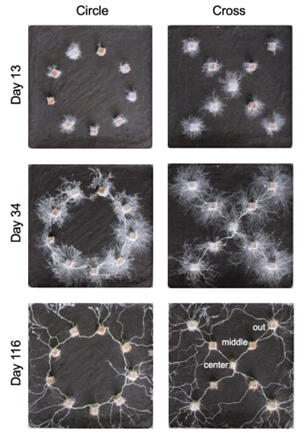Fungi do not have eyes or brains, but they may be able to recognize shapes. A research group led by Associate Professor Yu Fukasawa of the Graduate School of Agricultural Science at Tohoku University incubated mycelia of the wood decay fungus Phanerochaete velutina colonizing nine wood blocks placed in the circle (〇) and cross (✕) arrangements on a culture medium. They found that the fungus not only developed the mycelial network in the circle and cross shapes but also showed different levels of wood decay activity depending on the shapes. The study was published in Fungal Ecology.

Provided by Yu Fukasawa, Tohoku University.
The hypha of fungi grows in forest soil to form a networking body called the mycelium, which mediates the translocation of water, carbon, nutrients, and other substances, playing an important role in forest material cycling. Some species of wood-decay fungi are known to form mycelial networks that connect multiple dead trees scattered on the forest floor, with the largest reported mycelial network spreading over a more than 900-hectare area. Recent reports have documented a variety of intelligent behaviors (memory, learning, decision-making) of the mycelium of wood-decay fungi. However, it has not been well understood how the mycelia recognize the external environment.
Nine wood blocks (1 cm square cubes) colonized by the mycelium of the wood-decay fungus P. velutina were placed in a circle (〇) or cross (✕) arrangement on a medium (24 × 24 cm) covered with non-sterilized soil, and the mycelium was allowed to grow on the soil. The mycelium growing on the soil developed a network of mycelial cords connecting the wood blocks, drawing a circle (〇) or cross (✕) shape.
The wood blocks collected after 116 days of incubation were weighed to determine percentages of mass loss and inspected to count mycelial cord connections per wood block. The research group examined their correlation and found that the mass loss was greater for wood blocks with more mycelial cord connections. Furthermore, the wood decay activity of fungal mycelia drawing the circle (〇) shape was greater than that of mycelia drawing the cross (✕) shape. Shape recognition in the visual cortex of the animal brain is known to be associated with the activation of different neural networks depending on the shape.
The activity of the mycelial network differing depending on shape observed in this experiment may be similar to network activity in the brain differing depending on shape that has been observed in the brain's shape recognition process. In that sense, these findings could mean that fungal mycelium can recognize different shapes. The results may contribute to understanding the mechanisms of intelligent behavior of mycelia and the development of biocomputers based on mycelial mechanisms.
Journal Information
Publication: Fungal Ecology
Title: Spatial resource arrangement influences both network structures and activity of fungal mycelia: A form of pattern recognition?
DOI: 10.1016/j.funeco.2024.101387
This article has been translated by JST with permission from The Science News Ltd. (https://sci-news.co.jp/). Unauthorized reproduction of the article and photographs is prohibited.




